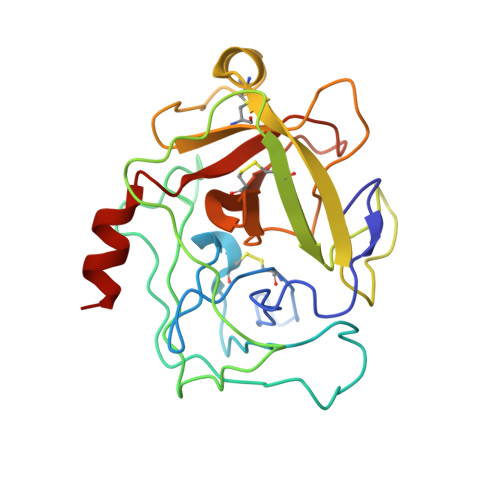Crystal structure of bovine duodenase, a serine protease, with dual trypsin and chymotrypsin-like specificities.
Pletnev, V.Z., Zamolodchikova, T.S., Pangborn, W.A., Duax, W.L.(2000) Proteins 41: 8-16
- PubMed: 10944388
- Primary Citation of Related Structures:
1EUF - PubMed Abstract:
The three-dimensional structure of duodenase, a serine protease from bovine duodenum mucosa, has been determined at 2.4A resolution. The enzyme, which has both trypsin-like and chymotrypsin-like activities, most closely resembles human cathepsin G with which it shares 57% sequence identity and similar specificity. The catalytic Ser195 in duodenase adopts the energetically favored conformation typical of serine proteinases and unlike the strained state typical of lipase/esterases. Of several waters in the active site of duodenase, the one associated with Ser214 is found in all serine proteinases and most lipase/esterases. The conservation of the Ser214 residue in serine proteinase, its presence in the active site, and participation in a hydrogen water network involving the catalytic triad (His57, Asp107, and Ser195) argues for its having an important role in the mechanism of action. It may be referred to as a fourth member of the catalytic triad. Duodenase is one of a growing family of enzymes that possesses trypsin-like and chymotrypsin-like activity. Not long ago, these activities were considered to be mutually exclusive. Computer modeling reveals that the S1 subsite of duodenase has structural features compatible with effective accommodation of P1 residues typical of trypsin (Arg/Lys) and chymotrypsin (Tyr/Phe) substrates. The determination of structural features associated with functional variation in the enzyme family may permit design of enzymes with a specific ratio of trypsin and chymotrypsin activities.
Organizational Affiliation:
Shemyakin-Ovchinnikov Institute of Bioorganic Chemistry Russian Academy of Sciences Ul, Miklukho-Maklaya, Moscow, Russia.
















